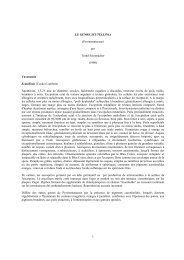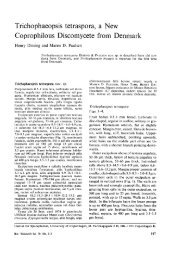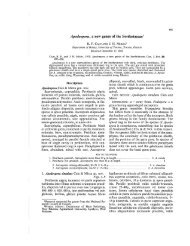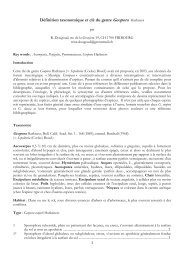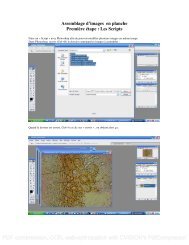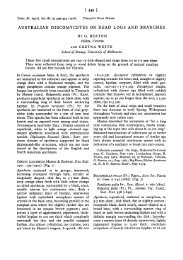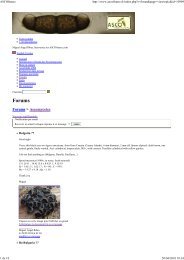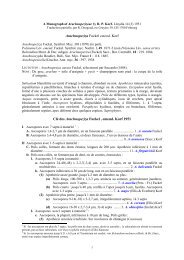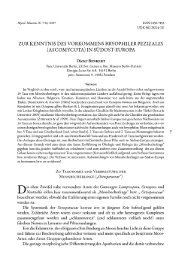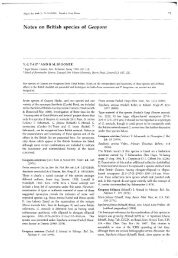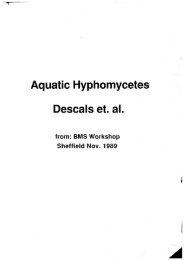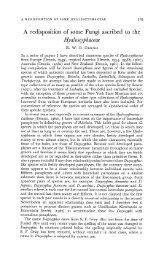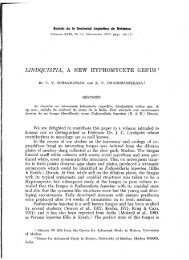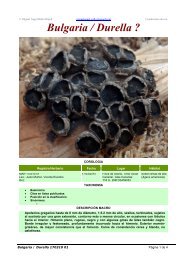Stray Studies in the Coronophorales (Pyrenomycetes) 4-8 - ASCOfrance
Stray Studies in the Coronophorales (Pyrenomycetes) 4-8 - ASCOfrance
Stray Studies in the Coronophorales (Pyrenomycetes) 4-8 - ASCOfrance
You also want an ePaper? Increase the reach of your titles
YUMPU automatically turns print PDFs into web optimized ePapers that Google loves.
294 J. A. Nannfeldttuberculations are formed by aggregations of ± globose cells with walls thicker anddarker, especially peripherally. In a few species some peripheral cells run out <strong>in</strong>topo<strong>in</strong>ted, sp<strong>in</strong>e-like processes, which <strong>in</strong> N. brevisp<strong>in</strong>a have an average length of ca.10 ¿im (Munk 1957:185, fig. 67) and <strong>in</strong> N. broomeiana, where <strong>the</strong>y often are forkedand/or provided with secondary "barbs", may reach a length of 25 /urn or more. InAc. argent<strong>in</strong>ensis, Ac. foveolata and Ac. pulchella <strong>the</strong> ascocarps are armed with arestricted number of easily broken-off bristles agree<strong>in</strong>g with those of <strong>the</strong> subiculum(see above).The basic shape of <strong>the</strong> ascocarps <strong>in</strong> HöhnePs Coronophoreen (excl.Coronophorella)is subglobose or broadly ellipsoid, without ostiolum and apical papilla, shrivell<strong>in</strong>girregularly on dry<strong>in</strong>g and only rarely dist<strong>in</strong>ctly tuberculate. The ascocarps arerelatively large, <strong>in</strong> some species (e.g. Coronophora gregaria) even very large,reach<strong>in</strong>g almost 2 mm <strong>in</strong> diameter. The structure of <strong>the</strong> peridium agrees with that <strong>in</strong><strong>the</strong> Nitschkieae.The ascocarpic wall is only slightly thicker basally.In <strong>the</strong> two genera later added to <strong>the</strong> <strong>Coronophorales</strong>, Bertia (moriformis) andGaillardiella (pezizoides)<strong>the</strong> ascocarps possess well developed basal parts. In <strong>the</strong>former <strong>the</strong> ascocarps are subcyl<strong>in</strong>drical, large and high (up to 0.7x1 mm) and verycoarsely tuberculate (whence <strong>the</strong> specific epi<strong>the</strong>t). They have no apical papilla anddo not collapse on dry<strong>in</strong>g. The apex is unrecognizable externally because of <strong>the</strong>tuberculations, but th<strong>in</strong>, exactly median sections show a small "plug" with specialanatomy simulat<strong>in</strong>g an ostiolum (Figs, la, b). Due to its m<strong>in</strong>uteness <strong>the</strong> "plug" wasmissed by Luc, Munk, and Parguey-Leduc, but it was illustrated and described byMüller & Arx (1962:816-818).The ascocarps of G. pezizoides are also ra<strong>the</strong>r large (up to l.lxl.l mm) andsubcyl<strong>in</strong>drical but collapse cupulately on dry<strong>in</strong>g. The extant material (<strong>in</strong> FH) is nowso poor that we have <strong>in</strong> <strong>the</strong> ma<strong>in</strong> to rely upon <strong>the</strong> detailed studies by Petrak (1953a)and Müller & Arx (1952:818-820). The latter authors, who also draw a section,recognized it as Coronophoralean. It approaches Nitschkia by <strong>the</strong> collaps<strong>in</strong>gascocarps, but deviates markedly by <strong>the</strong>ir size and, especially, by <strong>the</strong> strong circularthicken<strong>in</strong>g of <strong>the</strong> peridium round <strong>the</strong> "cup"."Munk pores" (Nannfeldt 1975:51) have been observed <strong>in</strong> all members studied byme, thus also <strong>in</strong> <strong>the</strong> large-fruited (true) Coronophora gregaria, where Munk himselffailed to see <strong>the</strong>m, but <strong>the</strong>ir obviousness is very variable, depend<strong>in</strong>g both upon <strong>the</strong>species and <strong>the</strong> stage.The pores are ca. 1 p.m <strong>in</strong> diam. and surrounded by a r<strong>in</strong>g-shaped thicken<strong>in</strong>g of <strong>the</strong>wall, which makes <strong>the</strong>m look like m<strong>in</strong>iatures of <strong>the</strong> r<strong>in</strong>g pores of <strong>the</strong> conifers (Fig.2e). Their number varies with <strong>the</strong> species. As a rule <strong>the</strong> common wall between twocells shows only one pore, but on some occasions a higher number seems out ofdoubt.By <strong>the</strong> way it may be mentioned that Patouillard seems to have been <strong>the</strong> first to observe <strong>the</strong>sepores. He drew <strong>the</strong>m carefully <strong>in</strong> a pencil sketch accompany<strong>in</strong>g <strong>the</strong> type specimen of hisSvensk Bot. Tidskr. 69 (1975)



